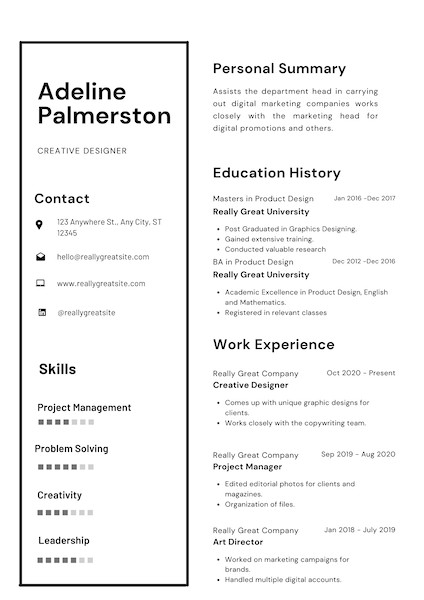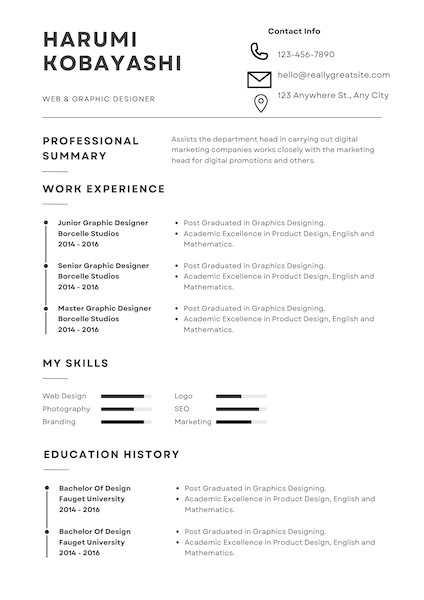
Writing resumés is a difficult task no matter where you live. How do you find the balance between professional and personal? At what point does concise become too little information? While most resumés across the world follow a similar kind of structure, there may be little details that are different in Canada that could impact your success.
Best practices
Here is a list of things employers in Canada want to see on your resumé:
Action verbs
An action verb indicates what a person does, makes, or takes. It is a word used to demonstrate a physical or mental action. These verbs are the best way to highlight your relevant experience without it getting lost in wordy explanations. If you want your resumé to stand out, use unique action verbs that showcase your personality like these:
- Empowered a group of students to present their project at a conference.
- Spearheaded a campaign to plant more trees on school grounds.
- Advocated on behalf of a children’s charity to clients in hopes of receiving donations.
Quantifiable examples
Don’t just tell an employer why you’d be good for the position — show them. The more numbers and evidence you can provide, the better you look for the role.
Check out the difference between these two statements discussing the same role:
- Managed a group of students while fundraising for a non-profit charity.
- Spearheaded a team of ten students in a fundraising project for a non-profit charity where we sold 5,000 raffle tickets, effectively raising $10,000 in one week.
The first statement tells the employer what you did, but the second statement provides concrete evidence of how effective you were in that leadership position.
Personal summary
A personal summary, also known as a professional summary or summary statement, is a small paragraph at the beginning of your resumé that highlights your best achievements, qualities, and skills. When writing a personal summary, it helps to ask yourself “if the employer only reads this part, what are the main skills I want them to know about me?”
A personal summary is like a cover letter, but in a much more condensed and generic way. Your personal summary should be a short sentence or two that caters to each job position through the skills you highlight. A cover letter is about a page in length and is where you make direct connections with the company and elaborate on how you will be an asset in that role.
What to avoid
The following items are things that Canadian employers don’t particularly like seeing on resumés:
Personal objective
Don’t confuse an objective statement with a personal statement. Objective statements are a small paragraph at the beginning of a resumé where you state your goal of being hired for the position. Pretty redundant, right? Personal statements have replaced these and provide employers with a better first impression of you.
References
Resumés need to be concise, so if you list your references, you’re taking up valuable space that could be used to further convince employers that you’re the best candidate. If they want references from you, they already know to ask for it.
Personal information
In India, and some European countries, including personal information on a resumé is common. People may include their age, gender, nationality, or marital status. However, in Canada that information is controversial and is best to leave out entirely to prevent any potential bias from employers.
The only personal information you should share on your Canadian resumé is your name, address or city, email, phone number, and your LinkedIn profile link. Make sure you have a professional email address that is something as simple as your name.
Photos / headshots
While this is common to include in other countries, it’s not very accepted in Canada. You want employers to focus on your skills and experiences as opposed to what you look like. Including a photo could potentially lower your chances of getting an interview.
Long lists
Your resumé should be concise and easy to read. Limit the number of bullet points you use for each section so that employers can easily scan your resumé and identify key skills that they’re looking for. Aim for 3-6 bullet points per experience to keep it short and sweet.
Formatting tips
Now that you know what information to include and what to leave out, how should you format it?
Resumé style
In Canada, there are typically two styles of resumés: functional and reverse-chronological. Within each style of resumé you can choose to structure it whatever way best highlights your contributions. As a student, recent grad, or someone with little work experience, the best style you should use is the functional option.
- Functional resumés focus more on your education and skills as opposed to your work experience. Your education and skills sections of your resumé may appear before your work experience. Check out this sample template:

- Reverse-chronological formats focus on your work experience. This is a good resumé style to use once you’ve had a couple years of work after your graduation. Check out this sample template:

Length
A resumé should be no longer than two pages. If it’s any longer, it may appear to employers that you don’t know how to prioritize or be concise.
Design
Try to avoid adding photos, graphics, and lots of colour to your resumé. These can distract employers from the information you want them to see.
If you’re not too sure on how to style your resumé, there are plenty of templates available online! Check out Canva’s or the Government of Canada’s Job Bank’s free resumé builders.
Cover letters
A cover letter is typically required for most job positions in Canada. This is your chance to go more in detail about 2-3 of your experiences or skills, show off your personality, and make a connection with the company.
Every cover letter should be unique to each company. You should weave in information you know about the company and make connections with specific skills and experiences you have that directly connect with their position.
Keep these tips in mind while creating your resumé and you’ll increase your chances of success. Good luck job hunting!
Check out our Canadian Openings and Earnings career quiz
